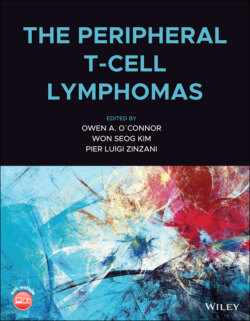Читать книгу The Peripheral T-Cell Lymphomas - Группа авторов - Страница 94
Historical Perspective
ОглавлениеThe epidemiology and classification of non‐Hodgkin lymphoma (NHL) has undergone vast transformation over the past few decades. Owing to an increase in incidence of the disease, a number of epidemiological studies were conducted, which led to a better understanding of the risk factors and the several subtypes of NHL. Despite these studies, the epidemiological data regarding peripheral T and natural killer (NK)‐cell lymphomas is limited, due to the low incidence of this disease when compared with that of B‐cell lymphomas.
Mycosis fungoides and Sézary syndrome were described as early as 1806 [1] and 1938 [2], respectively. However, they were considered to be a histological subtype in a broad group which includes all lymphomas, distinguished from others based on their growth pattern. The Kiel classification, proposed by Lennert and Luke in 1974, was used to classify the lymphomas, based on the tumor morphological and cytological characteristics [3]. It was not until mid‐1970s that they were both recognized to be a spectrum of cutaneous T‐cell lymphomas (CTCL) [4], and it was only in the late 1970s that the T‐cell lymphomas were proposed as a separate entity from B‐cell lymphomas [5].
Subsequently, with better understanding and characterization of the immune system, immunohistochemistry, and immunophenotyping were used to identify several subtypes of T‐cell lymphomas. This was first incorporated to develop the Revised European–American Classification of Lymphoid Neoplasms classification for NHL based on a consensus list by the International Lymphoma Study Group in 1994 [6]. With improved understanding of the diversity and pathobiology of the disease, several classifications have been developed, such as the World Health Organization (WHO) project, and the European Organization of Research and Treatment of Cancer. These classifications have been further refined, incorporating the genetic, immunophenotypic, and pathobiological advances made in this field. T‐cell lymphomas can be divided into those arising from precursor T cells termed as precursor T‐lymphoblastic lymphoma and those of more mature T cells, referred to as peripheral or mature T‐cell lymphomas (PTCLs). The 2017 WHO classification broadly divides PTCL into three categories based on their location. They are leukemic (disseminated), nodal, and extranodal. These categories are further subdivided based on morphology, immunohistochemistry, and clinical behavior. Examples of these lymphomas include PTCL not otherwise specified (PTCL‐NOS), angioimmunoblastic T‐cell lymphomas (AITL), anaplastic large‐cell lymphoma (ALCL), anaplastic lymphoma kinase positive (ALK+), ALK negative (ALK–) ALCL, intestinal T‐cell lymphoma, and breast implant‐associated ALCL (BIA‐ALCL). Since the 2017 WHO classification, numerous developments have resulted in a better understanding of the genetic basis of ALK+, ALK–, gastrointestinal T‐cell and GATA3 subtypes of T‐cell lymphomas. These changes will likely be incorporated into the next edition of the WHO classification [7]. The current WHO classification of T‐cell lymphomas is presented in Appendix 5.A.
